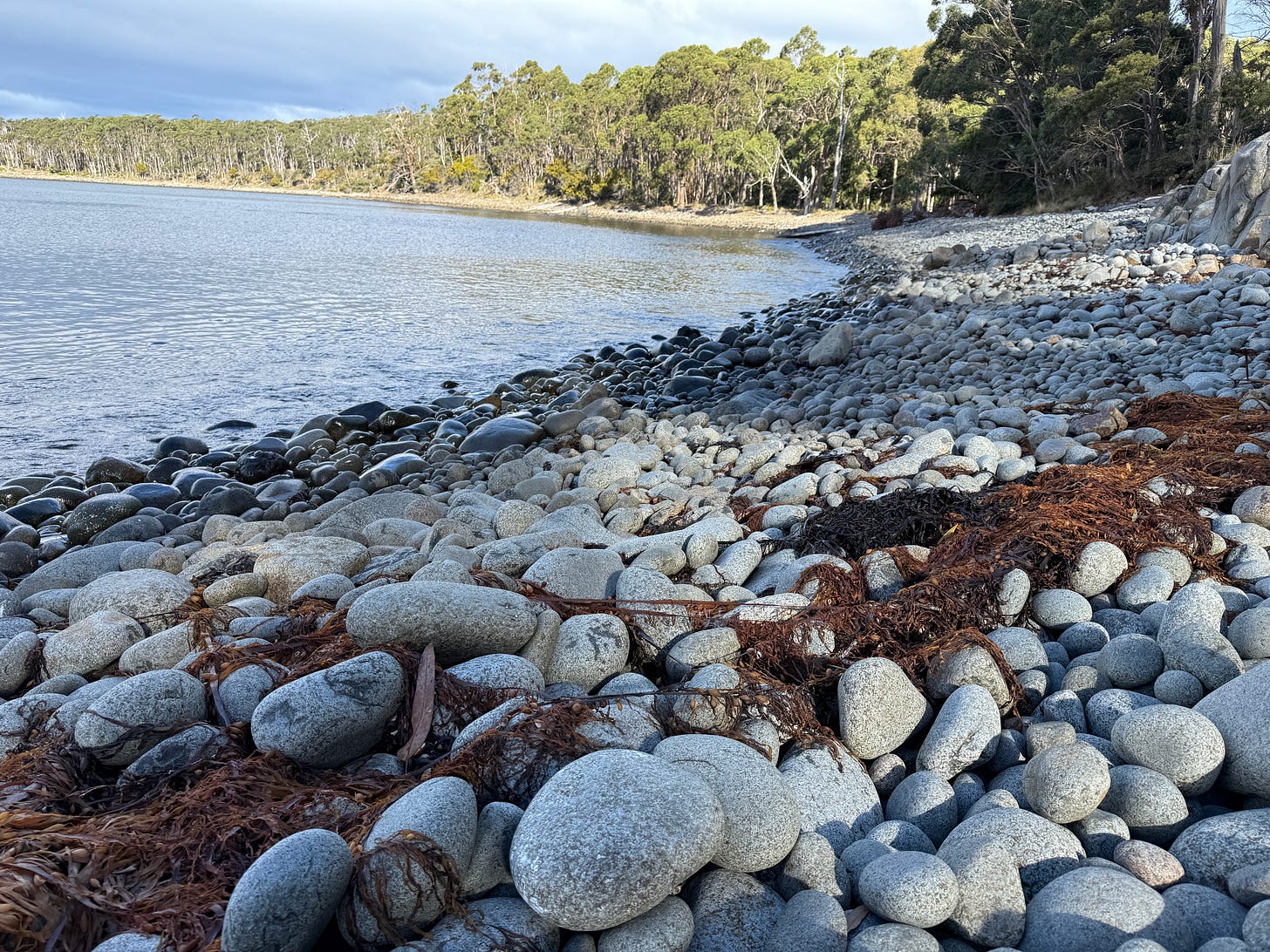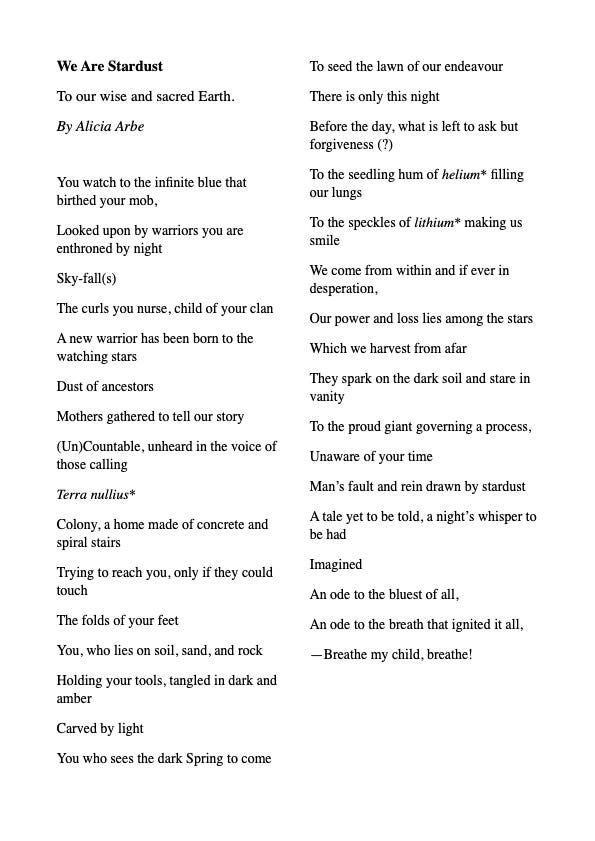If rocks could speak
An autumn afternoon by the sea
Hello lovely wild and wonderful readers,
It feels good to back writing to you. Oh, how I missed you all. I hope this last month has been gentle and kind.
My family and I had a bout of the flu (it will be an Easter to remember) but we dragged ourselves off the couch last week to explore the far south of Tasmania. Here’s a snippet from our Sunday afternoon at a tranquil cove in Sister’s Bay. I hope you enjoy.
Thank you for your patience, I know this letter is a smidge late, (the flu recovery has been long, but all kids are back at school now).
As always, I am grateful for your support, your comments, and your hearts. My days are warmer with you all.
With kindness,
Kate xx
It’s a warm autumn afternoon, the last day of the school holidays, and the end of a long week of illness. For the first time in days my family and I are upright and smiling, enjoying a walk together along a beach in the south of the Island of Tasmania. We are almost as far south as you can go by car. If we boarded a boat the next landmass south would be Antartica, and to the west, South America.
It is quiet here, nestled within the folds of Sister’s Bay. There are a handful of shacks scattered along the coast, and a few kilometres away, the sleepy hamlet of Southport, but despite this, there is nobody here but us. Tall eucalyptus trees grow just behind the beach, and here and there a native cheery tree, spotted by my ever hungry four-year-old (sadly, no cherries). It is not a sandy beach, but the resting place of a million time-worn rocks, lying as they have always done, side by side with the beautiful green sea.
All about there are great clumps of decomposing kelp. Auburn strands, drying to a mottled black on the grey and white speckled rocks. My eldest daughter finds a messy ball of kelp roots, lifts it up to show us, it is the size of her head, a gnarled and knotted ‘holdfast’. We imagine the strength it would need to hold on when the swell is up and the wind is wicked. But today the kelp can rest: the sea is calm, only wavelets are rushing the shore.
Around a headland we find the body of a seal. It’s skin leathered and peeling. A hive of wasps feasting on its body. The tail fin is gone, the base of its pearl white spine exposed to the air. Thankfully, the breeze is favourable and we cannot smell the rotting flesh as we dance along the rocks.
At first they are small and impossibly round. We crouch with bent knees and cradle their sun-warmed bodies in the palms of our hands.
Look at this one Mum, my children call. And this one.
We marvel at their deliciously smooth salt and pepper skin, it is as soft as a newborn’s. And for a brief moment, we are mesmerised. For we each hold a creation born from the movement of water and weather and time, an endless cycling and tumbling, eddying millions-of-years-old magma into an exquisite sphere.
As we move further out of the curve of the bay, to a long stretch of coast, the rocks become larger and more irregular. The colour changes too: to black, yellow, and brown, and I wonder if I am looking at a different type of rock. Perhaps it is a softer material, composed of the things that have come and gone before us — minerals, plants and animals. A sedimentary rock, perhaps? Though I am no geologist.
One day, I think, this will be us. We will become a layer of rock, all of our humanity compressed into the earth like a time-capsule waiting to be discovered.
*
My children find the bodies of three large felled trees, lying on the rocks, bleached of colour by the sun and lashed together with chains. The trunks disappear into the sea, jagged and slimily and black. All about there are rocks the size of bowling balls and my children start a game. They roll the rocks down the deep grooves between the trunks, a natural bowling alley. I worry that fingers and naked feet might be crushed, but my husband reassures me.
Let the children be, he says.
And I remember that this is the first time in a week they have been well enough to play outside, and the first time I have enjoyed some breathing space to think and write. How wonderful it feels to open my notebook and start writing this letter to you beside the sea.
*
With the sound of my children in my ears, I look out across the bay. On the far side of the D'Entrecasteaux Channel1, is the southern tip of Bruny Island. I can see the erect shape of the old lighthouse, and the white flash of what must be a huge swell smashing against the distant coastline. There are a few boats too, some moving with the angular grace of a sail, others with the strength of a motor.
To the north, I see the black teeth of a fish farm — a circular prison for thousands of Atlantic salmon. The churn of machinery shreds across the water, a familiar sound for Tasmanians living by the coast. The environmental damage caused by the fish farming industry has exploded into national headlines these last few weeks: oily globs, the remains of dead salmon, washing up on beaches; nutrient levels spiking; dissolved oxygen in the sea sinking dangerously low. Other species are suffering too, including the endangered Maugean skate. It is devastating. What have we done?
*
On Saturday, I’ll cast my vote in the Australian federal election. Opinions are everywhere — on fences, t-shirts, letterboxes, and even the sky, though for now, it’s a divided canvas: half cloud, half cerulean blue. But as I walk back along the beach to our van, with a notebook under my arm and my children’s jumpers tied around my waist, none of that seems to matter. Today, we bend to touch the unfeasibly soft curves of the time-worn rocks.
And we wonder — If the rocks could speak, what they would say?
A poem to the Earth
A few other things
April 22nd was Earth Day and to celebrate I joined a group of 28 writers to share stories and poems about ‘The Future of Nature’. A (re)imagining of the human / nature relationship. You can read my story here:
A big thank you to
and who organised this project, and who were supported by and Thank you also to publisher of TopEndFiction. You can read all the other fabulous stories and poems here:
Everything you need to know about the Australian Federal election ahead of voting on Saturday, in written and comic form, here.
This story about a very, very rare shell discovered by an eight year old Tasmanian girl.
I’m loving, There are Rivers in the Sky by
. What are you reading?
Wishing you a wonderful week dear readers,
and an afternoon to sit by the sea and dream.
Kate xx
The D'Entrecasteaux Channel is a body of water that separates Bruny Island from the Tasmanian mainland and runs roughly north–south, stretching from the Derwent Estuary near Hobart down to the Southern Ocean. It was named after the French explorer Bruni d’Entrecasteaux, who navigated it in 1792 while searching for the lost expedition of La Pérouse.







So many beautiful lines in this one Kate. Sister's Bay sounds just perfect. I'm glad you're all over the flu and back doing the things you love.
Beautiful, Kate. Glad you’re all on the mend. I’m traveling and so behind on the stories. Looking forward to reading yours. 💚